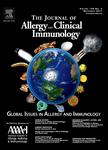版权所有:内蒙古大学图书馆 技术提供:维普资讯• 智图
内蒙古自治区呼和浩特市赛罕区大学西街235号 邮编: 010021

作者机构:UNIV CINCINNATI MED CTRDEPT MEDDIV IMMUNOLML 563 231 BETHESDA AVE CINCINNATI OH 45267 USA WRIGHT STATE UNIV DEPT BIOL SCI & PHYSIOL DAYTON OH 45435 USA
出 版 物:《JOURNAL OF ALLERGY AND CLINICAL IMMUNOLOGY》 (变态反应与临床免疫学杂志)
年 卷 期:1987年第80卷第4期
页 面:586-590页
核心收录:
学科分类:1002[医学-临床医学] 1001[医学-基础医学(可授医学、理学学位)] 100201[医学-内科学(含:心血管病、血液病、呼吸系病、消化系病、内分泌与代谢病、肾病、风湿病、传染病)] 10[医学]
主 题:AC American cockroaches H Hemolymph BB Brown-banded cockroaches GC German cockroaches F Fecal PD 50 Provocative dose of allergen required to cause a decrease of 50% of nasal flow rate from baseline Tm Tenebrio molitor
摘 要:Six laboratory workers who were exposed to American cockroaches (AC) and German cockroaches (GC) while they were performing immunologic experiments were evaluated for cockroach hypersensitivity. Prick skin testing and RAST were performed with whole body extracts (1:20 wt/vol) of AC, brown-banded (BB), and GC species as well as hemolymph and fecal (F) extracts of AC. Three of six workers reported work-related nasal and ocular symptoms associated with xenografting and bleeding of cockroaches. All three symptomatic workers exhibited cutaneous reactivity to at least one cockroach antigen. Elevated RAST binding was observed in on eof the three symptomatic workers. A nasal provocation to AC was positive in the most symptomatic worker at a provocative dose of 3.2 .times. 10-3 mg causing a 50% decrease of nasal flow rate from baseline. After pretreatment with nasal cromolyn, the provocative dose causing a 50% decrease from baseline increased to 2.6 .times. 10-1 mg. Nasal provocation with the same concentrations of AC were negative in two skin test negative subjects. RAST-inhibition studies demonstrated cross inhibition of the serum-specific IgE binding to AC-hemolymph by AC, GC, and BB whole body extracts. However, specific IgE binding to AC-F was inhibited by AC-F and AC but not by GC or BB whole body extracts, suggesting there was greater specificity of the F allergens. This study demonstrated that cockroach allergens elicit IgE-dependent upper respiratory sensitization in the workplace.